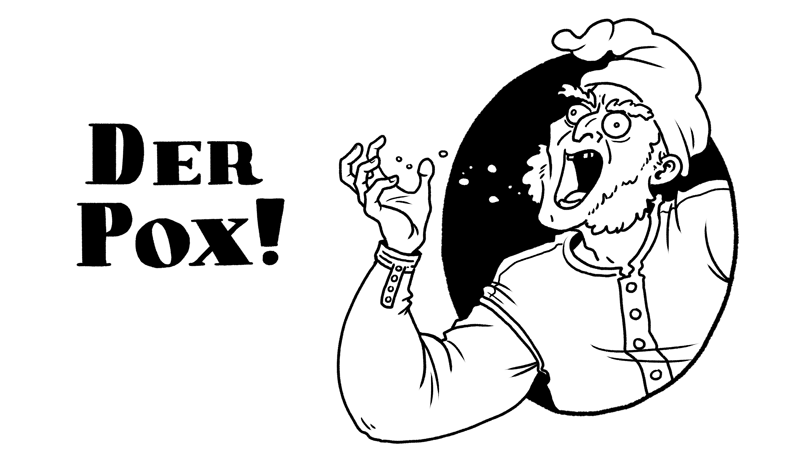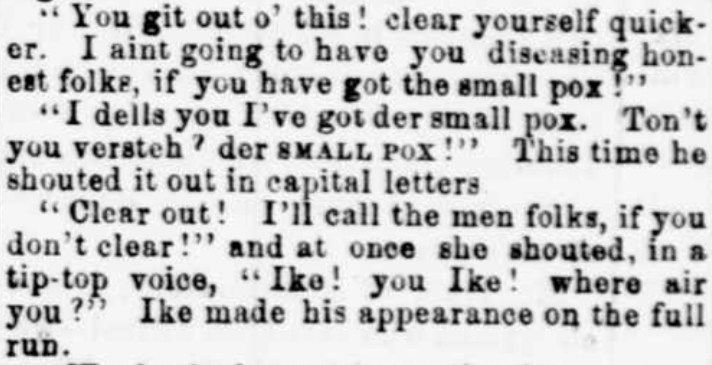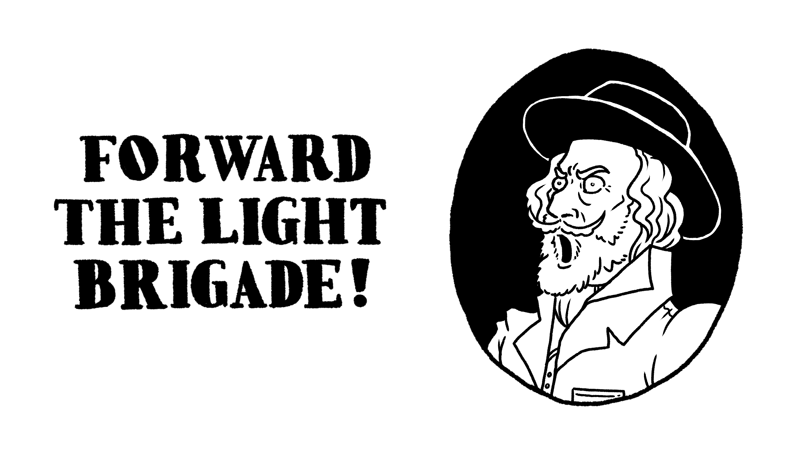CAPITAL CRIMES, PART 1 : SHOUT, SHOUT, LET IT ALL OUT
46Hello, everyone! This is the first installment in a regular series of researched and reported stories that @dave asked me to write about things of broad interest to the community. I'll be writing about Internet culture and quirky technology and language, among other things. I've been reporting about oddments related to tech for over 20 years, and I'm looking forward to getting to know everyone!
WHY AM I YELLING? Because I have important, breaking news from 1856 about a truly uppercase notion.

If you’re reading this article on a screen, you certainly know that THESE ARE CALLED SHOUTY CAPS. The use of all uppercase letters in email, on web pages, in forums, and beyond has meant that someone is angry, confused, or elderly—or a combination of all three. Even if they didn’t MEAN TO SHOUT, you certainly HEAR IT AS SHOUTING INSIDE YOUR HEAD. Unintentional caps denote cluelessness; if intentional, jerkiness.
The National Weather Service (NWS) paid homage to this recently, noting on April 11, 2016: “LISTEN UP! BEGINNING ON MAY 11, NOAA’S NATIONAL WEATHER SERVICE FORECASTS WILL STOP YELLING AT YOU.” The use of only uppercase letters by the NWS dates back to 1928, with the installation of teleprinters that could be remotely controlled to type out news reports. The NWS has finally retired the last vestiges of these elder systems, allowing it to switch to mixed case.
Previous articles on this subject—such as this previously definitive short at the New Republic—trace the explicit association of capitals with yelling (as opposed to mere emphasis) to 1984, with inferences a few decades before that.
I’m here to BLOW THIS OUT OF THE WATER, with a series of citations that date back to 1856. People have been uppercase shouting intentionally for a century more than recollected. And, as with so many things, longtime Internet users want to claim credit, when they really just passed on and more broadly popularized an existing practice.
I suspected a longer history because I’m a recovering typesetter, a one-time member of a now nearly defunct profession of compositing type in lines and on a page, whether in metal, wood, or bits. I was trained in the 1980s, probably among the very last in a line stretching back to not long after Gutenberg. I studied graphic design and its history in college and have read extensively on the subject since.
In all my typographic reading, I’d never come across an explicit connection between all capitals and yelling, but I knew two things: First, capitals and lowercase developed not in lockstep but from different methods of inscribing or writing; second, uppercase letters have been used for millennia for emphasis and importance.
Sue Walker, the director of collections and archives in typography at the University of Reading, England, found an apposite description in a 1674 book, The Compleat English Schoolmaster, by Elisha Coles. The author wrote that a whole word in capitals “is alwa[y]es more than ordinarily remarkable; as some signal name, Title, Inscription, or the like...”
But surely, I thought, there must be some more direct correlation out there—not just an insinuation or a practice, but writers (or fictional characters) explaining it to a reader.
AND, YES, THERE IS. But let’s start with the reveal before diving into the full history and a novel theory I have about shouty caps’ disappearance and re-emergence.

Small Pox in Small Caps
The first clear citation I can find is in the Evening Star, a Washington, D.C., newspaper. It appears on February 28, 1856 and was syndicated to other papers around the same time. In a “hilarious” dialect story about a Dutchman who seems to be disease-ridden, this wonderful sentence appears:
[“]I dells you I’ve got der small pox. Ton’t you vetsteh? der SMALL POX!” This time he shouted it out in capital letters.

The words “small pox” appear in capitals—well, small capitals, a variant I’ll explain in a moment—but there’s our smoking gun. The way the sentence is phrased makes it clear that the convention of capitals meaning shouting has already become part of readers’ consciousness. (By the way, the Dutchman of the story was trying to deliver a “small box.”)
I found a small but significant cascade of newspaper and book references following that. The Ottawa Free Trader in 1860 notes that a story in another newspaper announced an election “in grand glaring capitals and head letter shouts of victory.”
In 1870, the Shamrock (Ireland) published part 3 of a fictional account labeled “The Sore Grievance of Wellspanked John.” At one point, the narrator is thrown into a great basket of duck eggs, and after that his aunt is told she must pay for them:
“TWELVE shillings and SEVEN pence?” roared my aunt in the biggest capital letters—“Twelve and seven pence! Good gracious me!”

There’s also a clear connection in elocution manuals. For instance, an 1880 book, The Standard Speaker and Elocutionist, explains the convention to readers. “As examples, note the following selections marked in CAPITAL letters as the appropriate place for shouting emphasis.” It then proceeds to mark up part of Alfred, Lord Tennyson’s “The Charge of the Light Brigade.”
There are more, too, such as “The enthusiasm of the shout in capital letters” (1885), “warning signals which flash up in front of his eyes and shout in capital letters, SLOW DOWN!” (1913), and the like. I am sure there are more and earlier examples in which people used the convention without the archness of mentioning it.

Paul Luna, an expert in the design of complex text and a professor at the University of Reading, points out that these examples of mine and others he found separately demonstrate a “moralistic sense”: “The association with pomposity, bureaucracy, and self-importance crops up too often.” He notes, “No one seems to think that the use of capitals (whether in writing/print or by analogy in speech) is unequivocally a good thing!”
Starting in about the 1920s and through the 1980s, I can’t find anything of the sort available from the 1850s to 1910s. This is partly due to copyright eccentricities: Everything published in America before 1923 is in the public domain and more readily digitized and searched; starting in 1923, it’s a complicated mix. I consulted Google Books, Newspapers.com, Amazon (which has full-text search of some modern books), and other sources and found almost nothing.
Before we leap forward, though, let's take a pause before we step back in history in Part 2. Tune in to this space in a week, on May 19, when we see SHOUTY CAPS rise again as part of our common understanding.
- 25 comments, 45 replies
- Comment
TLDR
@lichme
Something about sandwiches I think.
@lichme Ah, good suggestion for a future article - the history of tl;dr.
@dave
Could that one be kept to 5 words max? Anything else wouldn't be as funny.
@dave Yeah, I'll be down for reading that. I mean, why would a deer decide teal to be their color? Why not green? Or red? Or purple?
@lichme TL;DR - LIIIIIIIIIIIIIIIIIIIIIIIIIIIIIIIIIIIIIIIIIIICH!
@carl669 CAAAAAAAAAAAAAAAAAAAAAAARL
@dave I always unpack that as, "too lazy, didn't read".
WHAT A GREAT ARTICLE
@therealjrn SPEAK UP, YOUNG PERSON
Ummm, does anyone else think this particular enterprise seems oddly similar to "The Debunker with Ken Jennings" over on Woot?
@compunaut how do you know @glennf isn't Ken Jenning's pseudonym?
@compunaut We'd ask Ken to debunk that notion but then we'd have to kill him to end the loop.
@compunaut I haven't read Ken's work there, but, ahem, I am also a Jeopardy! winner. (Only twice, sadly.)
@carl669 Don't care about KenJen's sudo, just find it weird to see a long-form story/article on Meh, where it will almost certainly always (even if affectionately) be peppered, poked, and prodded with TL;DR
On an almost completely random tangent, who (what?) is the most famous Ken? Barbie's BFF, or someone (thing) else?
@snapster @carl669 You could make a video of Ken and Glenn in the same room talking to each other - like the ones with Matthew and the other Glenn. That should prove they aren't the same person!
@rockblossom I have met Ken (he also lives in the Seattle area). He was incredibly generous with his time before I played Jeopardy, when I was just trying to get my sea legs on what I'd be facing.
@glennf Do you use the old board game version or a newer computer game ? I'm quite the champ at the old board game version myself -- and I've won more than twice !
Did anyone help you get your "sea legs" on what you would be facing here ?
@ceagee I don't have or use, either! I hadn't watched the show for a few years before I was cast (had canceled cable and didn't have an OTA antenna), but then put an antenna on the roof and watched it hard for weeks, plus studied all the archived text versions of the game on J-Archive
Mr @dave eased my way in here. (Hello!)
"Hey Everybody, It's Glenn!"
@KDemo WHAT'S THAT?!
@glennf "HEY EVERYBODY, IT'S GLENN!"
@glennf all the Incomparable Radio Theater listeners just lol'd.
History of language is fascinating, thanks.
Not on point, but I must note the best line: “I ain’t going to have you diseasing honest folks . . .”
@KDemo The whole story is basically laughing at a Dutch accent! Like the equivalent of a full column top to bottom of a newspaper, telling a story about a person mispronouncing "small box."
@KDemo Verbing weirded language even back then!
@glennf @KDemo you blooming Yanks still can't tell the difference between a Deutschmann and a Dutchman. Or am I kvetching too much?
@jaspio Ich nich Versteh?
I seem to remember street signs when only the first letter was capitalized: Main Street etc. However, I don't remember any traffic signs that weren't in all capitals. I mean, 'Stop' doesn't have the same impact as 'STOP'. (Keep writing, my father was a printer and I grew up among linotypes and letterpresses.)
@therealjrn

http://shirt.woot.com/offers/dangerous-font
@narfcake @therealjrn
"BE STILL, MY BEATING HEART."
"I SAID, 'BE STILL, MY BEATING HEART'. WHAT, ARE YOU NOT PAYING ATTENTION? DO I NEED TO TELL LOUDER?"
@f00l
DIDN'T WE HAVE A DISCUSSION ABOUT THIS EARLIER THIS WEEK? YOU NEED TO SPEAK UP
@FroodyFrog p u r e e v i l
@glennf
WHAT DID YOU SAY? MISSED THAT. PLEASE SPEAK MORE SLOWLY AND DISTINCTLY!
I came to this thread because on days I'm drinking heavily I like to tell stories of my slightly colorful past to strangers, but instead was rewarded with an interesting story and no feeling obligation to delete when I thought better of it. Thanks!
@Pantheist does that mean you are drinking now (OR PERHAPS I SHOULD SAY THEN)?
Is this the line for the mini eggrolls?
If things like this interest you at all, you have to check out Type Rider!
Type Rider:
Uncover the history and secrets of Fonts & Characters in a fascinating and unique experience!
Play as 2 dots and travel through the ages of typographic styles and techniques.
From the rock paintings of prehistoric times to Pixel art of the 2000’s, solve all the riddles by riding the most popular fonts and characters (Garamond, Helvetica, Times New Roman, Pixel, Comic Sans...) in a very captivating musical and visual environment.
On Steam- Windows, Mac, Linux
On iOS
On Google Play.
Started this thread high as fuck.
NOW SOBER.
@Pavlov
How bout now??? lol
It's actually a very fascinating read, actually. But yes. Very sobering.
@Pavlov
Woah, you sober up fast.
Holy shit, it's Glenn Fleishmann. Very cool, look forward to seeing more of these!
@brhfl Ok everyone can stop googling. HERE'S HIS WEBSITE
@ceagee The Jeopardy ILLUMINATI are TAKING OVER THE INTERNETS.
@brhfl Also, holy shit I spelled his name wrong. Sorry, @glennf!
@brhfl Buh-jello, heffy body!
I guess us regulars on the forum aren't stimulating enough for dave, so he had to bring in a ringer.
@hallmike
Well it couldn't be our lack of class.
@f00l

@hallmike The good news is that now @jasontoon doesn't have to be lonely anymore as the only staffer without a flask.
@hallmike you rang? oh wait...
@cshillaber He brought in a ringer, cuz I'm a ding-a-ling.
Personally I appreciate all caps 'cause I'm totally deaf in the right ear and losing the left.
^word
As a relic of a typesetting a little behind Glenn (I started around 1990, just as desktop was coming in), I liked the way different forms of type interacted. I designed books, which allowed me quite a bit of freedom within some strict constraints. The physical book dimensions were set and every one needed headers and page numbers (even on left, odd on right) and margins.
I bring all this up because of a particular book I typeset in the mid-90s. I've long since forgotten the content, but it was a controversial topic. I wanted to give the book a restrained, almost classical design which would give the words a sort of inferred authority. I decided to set the book in a single typeface, using a single size, all roman, as if I only had access to one type case. The "h3" subheads were in all caps—screaming for attention if you will—while the higher level headers were all caps with space put in between each letter. It all came out well and the author was pleased.
My constraint was self-imposed but the limits of computer keyboards certainly must have inspired all caps to become so widely used in the early days of the internet. I wonder if emoji's everywhere have made it less ubiquitous.
@Martinkelley I've often thought about book design (and read a few books on it) but never found the opportunity to actually design anything longer than a magazine. I love how tweaking even the subtlest aspects of space - page margins, leading, paragraph spacing - can change the tone and feel of the book.
I wouldn't have thought of spacing out the headers to increase their prominence without changing the type size. That's clever.
Holy crap I read all that. Good stuff.
Geez, some people are longwinded.
Good read.
I followed the link here from Daring Fireball. I saw “Glenn Fleishman, writing at Meh” and thought “what the hell is Gruber smoking?” But here is @glennf writing at Meh. Whoulda thunk?
It’s the new thing!
Another interesting find — a comic book panel from 1954:
It looks to me like the Dutchman said “versteh,” not “vetsteh.” Typo? Also maybe the first post should be updated with a link to part 2?
@jqubed Oh, yes! I’m increasingly of the mind this a “Dutchman” as in “deutsch man,” like the corruption of deutsch in Pennsylvania Dutch.
@glennf Ich verstehe kein Niederlandisch.
I really enjoy your articles @glennf, thanks for writing them!
@glennf As in my totes Germanic-descended momma calling me a “Hard-headed Dutchman” all my life, when we haff nein Hollandaise [Niederlander] in our heritage…
I may have found an earlier citation: 1816. It’s not as perfect as the 1856 one, but it’s pretty good.
@glennf